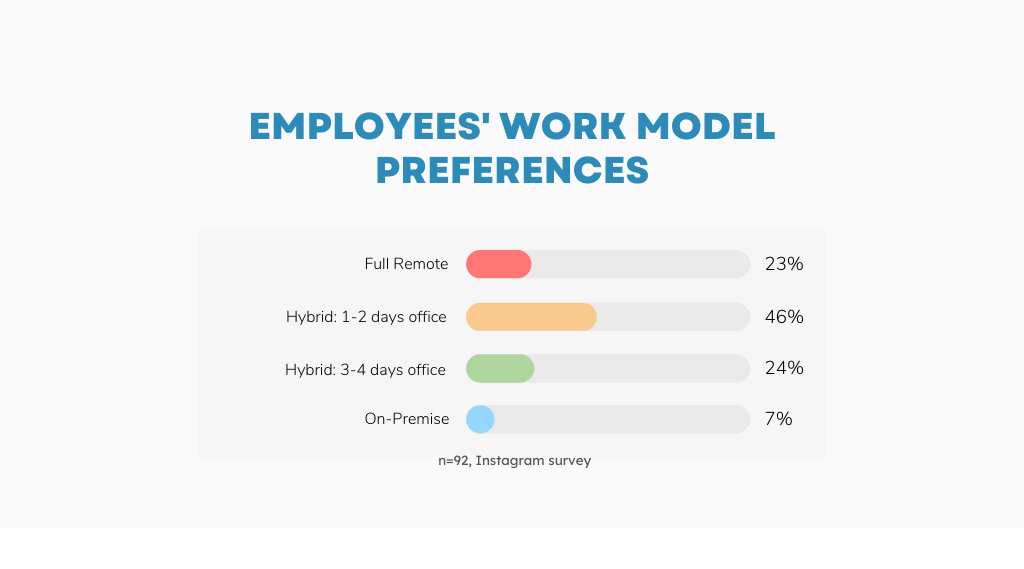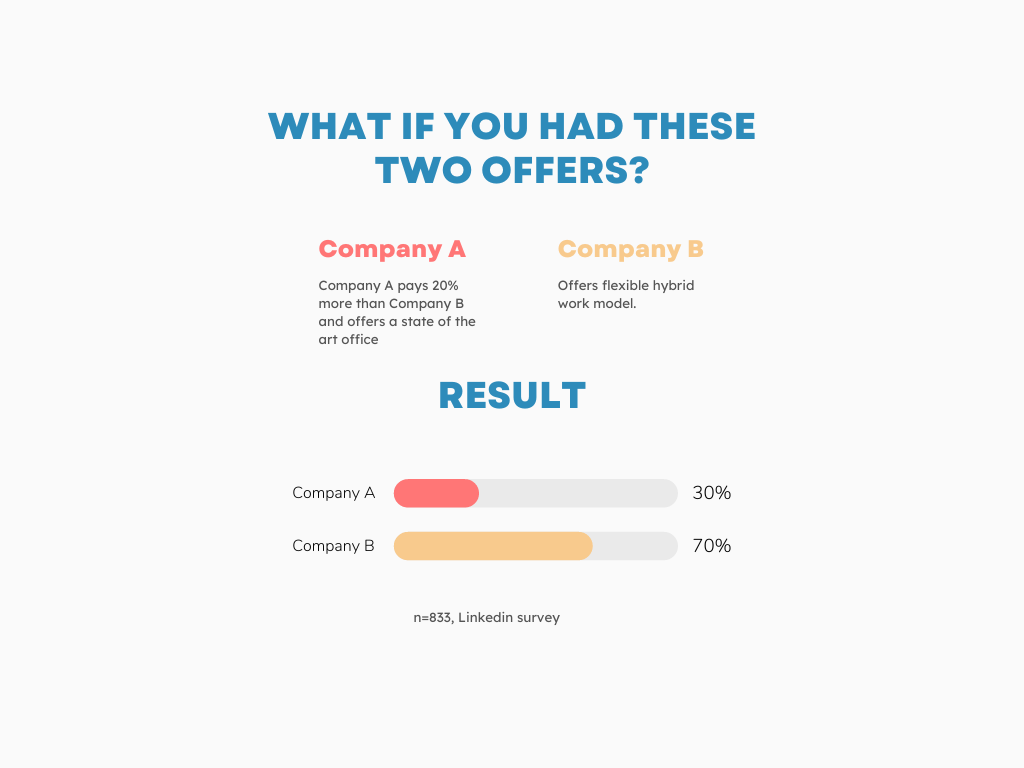The pandemic is almost over, and many companies call their staff back to the office. However, the traditional way of working is a big no-no for many employees, particularly after experiencing the comfort and flexibility of remote work. So there is considerable tension between employers and employees about returning to offices. The hybrid work model emerged as a middle ground between work from home and on-premise work. We have conducted several surveys, and employees’ preferred work choice is a flexible hybrid work model.
Do employees prefer remote and hybrid work models?
We have conducted several surveys, and employees’ preferred work choice is a flexible hybrid work model. According to one of our surveys only 7% of the participants want to work on-premise work:

Employees prefer companies with a flexible hybrid work model over on-premise ones, even though the latter pays better.

But is the new model right for you and your business? This ultimate guide explores the pros and cons of working in a hybrid model in depth!
What is hybrid work?
Before diving into the definition of hybrid work, it is best to review different remote work models discussed among HR professionals.
Different types of remote and hybrid work models
On-premise work model: Traditional office work. Your workforce goes and works in an office like we used to do.
Full remote work model: In this model, basically everyone works remotely, and no one has to work in company offices.
Remote first work model: Employees are expected to work remotely, and this is encouraged by the company. Companies operating in this model still have to keep some office space because people may still need to work in company offices from time to time.
Hybrid Work Model: In this model, some determined departments or a portion of the company work remotely, and the other portion operates in an office. This model is also called partly remote hybrid too.
Flexible Work or Flexible hybrid model: Any employee or department can work entirely remotely or in an office.
Choose-your-own-adventure work model: This model is much like the flexible hybrid model but with one exception: the company asks employees to choose one of the work models mentioned above. Employees are expected to adhere to choice later.
In practice, companies mix flexible and hybrid work. So basically, with the hybrid work model, companies mean either a department or some of your employees work remotely, and some work in the office as a workplace. The term also implies that employees can work for a couple of days remotely or in the office. In that sense, both workplace and workdays are considered flexible.
The Pros of hybrid work
Work when, where and how you’re most productive
Several studies show working remotely increases employees’ productivity. One of the main reasons for low productivity in an office environment is that employees get interrupted every 20 to 30 minutes either for chit-chat, or they can be called to an unplanned meeting. It takes 25 minutes to focus on what we do after we get interrupted. Besides, I don’t even mention the conversations and noises around you.
In addition, some people perform remarkably better during different times of the day. For some, the best focus times are night; for others, it is mornings. Where we work matters for many people too. Some people really like to work in a cafe, and some need absolute silence. Hybrid work offers the utmost flexibility and options for working at our peak productivity and performing the best deep work.
Better work-life balance
The average commute time is 54 minutes for an American employee and 59 minutes for an English employee. So on average, we can safely say, we lose 1 hour per day on commuting. If grooming, preparing your best clothes, and other preparation activities are considered, the time invested in going to work is well above 1 hour. Besides, people get tired while commuting as well. Hybrid and remote work models let workers save this time. This promotes a better work-life balance.
Hire talent across the globe
One of the most important advantages of hybrid work for companies is the opportunity to hire talent from around the world. The labor cost is way cheaper in several countries compared to US and EU. The best part is that several platforms let companies hire extraordinary, cost-effective talent, such as RemoteOk and NomadList. However, if you only need a payroll management platform, Gusto or Remote will work fine.
Increase the Productivity of your Workforce
With hybrid work, your team has more freedom to do deep work. One study shows that we are distracted every 11 minutes, and it takes 25 minutes to refocus. These distractions add up to 2,1 hours per day. That is 25% of a typical workday! In the hybrid work model, your team may work remotely a couple of days a week to get some deep work done; they may also decide to come into the office for collaboration. In that sense, many consider the flexible hybrid model the best of both worlds.
Save on real estate expenses and gas
Working in an on-premise model is, in fact, a costly way of working. With a hybrid work model, you can significantly decrease the workspace you need by changing the committed desks to floating desks. Since you will need less space, you can rent a smaller office or work in co-working spaces. Some companies may even ask their employees to work with their own equipment as well.
The flexible hybrid model is also a way to save money for employees as well. Remember that these days, gas prices fluctuate between 3-5 USD per gallon.
Better Work Accountability
When teams work remotely, it is essential to use a tool like Flexytime to track time because you cannot give a punch card machine to everyone! FlexyTime not only measures when people start and stop working, but it also gives several insights about the productivity and well-being of your team while respecting your team’s privacy. This kind of tool improves work accountability immediately. This also promotes fairness as well. Many companies had not used this kind of tool when people were working in a traditional office. However, so many stayed under the radar and performed poorly while others worked hard. That was damaging the fairness of the companies. FlexyTime and likewise tools may help you judge your team’s performance better.
The Cons of Hybrid Work and Typical Pitfalls
Extra Effort For Fairness and Inclusion
When some of your team members work remotely, others work on-premise, on-premise team members have an unfair advantage over remıote members just because of proximity. On-premise workers can access decision-makers way more frequently and influence or change the decisions taken in a meeting as well. Therefore, you have to make an extra effort to be fair to everyone, particularly for meetings, company perks, and, performance evaluations.
Modify your meetings
Most important decisions are taken in meetings, but if your on-premise workers gather around a table and your remote workers are squeezed into zoom boxes in a conference room, you would create an unjust environment. That is why it is best for everyone to go to their desk and connect to meeting individually.
Performance Evaluations
Performance evaluations are another critical aspect. You need to focus on cold performance metrics. Otherwise, on-premise workers with whom you have launch and bond daily on some level will have a definite edge over remote team members.
Changing communication styles and adapting to asynchronous communication
Having remote team members almost always means different time zones. For apparent reasons making live, aka synchronous meetings, will be way more infrequent. Therefore you will need to send video messages, screen recordings, slack messages, and emails more often. Although it looks like a burden initially, this will help your company’s documentation process. It also prevents misunderstanding of any task you assign to your team.
Boost your cybersecurity and tech support
This one is important. IT support for company employees is generally notorious. When people work on-premise, they may have a chance to speed things up, but when you work remotely, you rely on a ticketing system. When working remotely, IT support must be phenomenal, so much so that your IT support must act like they are serving a real customer.
Cybersecurity is another important aspect if your team uses their own equipment particularly. We all know what an innocent USB may cause. Therefore, companies must use two-factor authentication for connections, secure company data, and assign different authorization levels for various roles.
How to adopt and build your hybrid work model
Gather continuous feedback and Survey your team
Before assuming anything, it is always to ask your team what they need. Every company and every team is a bit different. That’s why expectations may differ as well. The most important tip is to gather employee feedback continuously. Most companies ask once, and they leave collecting feedback to the annual employee satisfaction survey, which is costly. You have to give a lot of endeavors to understand the survey’s insights. That is why it is always to have more frequent feedback from employees.
Build the infrastructure that supports flexibility
We have mentioned that companies adopting and creating hybrid workplaces must invest in async communication tools and cybersecurity. But there is also a need to invest in software products for coordinating your office usage. At certain times, remote employees may want to visit the office, but considering you already saved on office space, a desk reservation tool might be necessary. Another important thing is that HR should create company policies about the flexibilities you offer. A set of rules, in that sense, will prevent any chaos.
Create a great workplace experience and company culture
Creating a great company culture is challenging, even if everyone works on-site. In the hybrid model, all the best practices must be updated. Everything must be reevaluated according to remote and hybrid working. However, once that is done, the hybrid model is very rewarding.
Be fair and inclusive
Fairness is one of the most influential aspects of social group dynamics. If your remote workers feel inferior compared to your team working in-office, discontent will arise. Eventually, you may lose precious remote workers. That’s why always remember evaluations to be fair in every aspect, including KPI evalations or even how you hold a meeting or how you distribute office supplies. Be fair in any perks you supply to your teams, whether they are remote or on-site.
When your team members share an idea, pay attention to it. Make every idea count and do your best to increase employee engagement.
Create a virtual community
One of the best advantages of working in an on-premise workspace is the opportunity to socialize and learn new things from people. Although it may disturb people’s focus or the related chit-chat may steal away productivity, this may promote creativity, and a sense of being part of a team and community. Being part of a group or community in a workplace promotes belonging and lets us feel we are more than a person struck in a zoom box.
Creating virtual communities and re-establishing a similar belonging feeling in hybrid workplaces as a is the ultimate challenge. Create as many virtual communities as possible. Use HR as a cheerleader to promote your virtual communities. Some people may need a hand to be more active in communities. Pay special attention to newcomers and young team members; try to create unique communities for those people.
Schedule wellness breaks
FlexyTime actively tracks the well-being of your team members. So you can spot if any of your team members are having burnout or any focusing problems. FlexyTime offers several other alarms to watch over the well-being of your team. Even though everything goes well, let your HR schedule wellness breaks in advance.
Schedule Company retreats
This is one of the best ways to have face-to-face talks with your remote team. And all your team members can meet and spend some together in-person and share the same physical space as well. This is also an important opportunity for upper management and your CEO to introduce themselves and company goals.
Be Flexible and open to new ideas
The goal of any business is to carry out its operations and make a profit. Remote working, and hybrid workforce is just new work options and ways. Be open to new ideas and have great empathy for your team. The old way of doing things changed, but the businesses’ goal remains the same. Connect, coordinate with your team and do your best to keep them happy and productive. And create the best work environment possible.
Wrapping up: What model is the future of work?
Remote work and on-premise work have their drawbacks. The best of those worlds seems to be a Flexible hybrid model, and companies seem to like the idea. Implementing that level of flexibility requires a huge dedication from the HR department and all management. Yet, the companies that acheived, Flexible Hybrid Work Model can reach a bigger talent pool, reduce overhead and salary costs, achieve higher job satisfaction, better documentation of processes, and more productive and happier employees.











